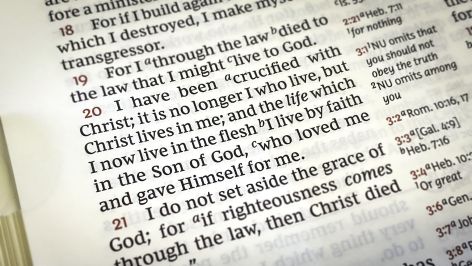What Is the Meaning of Galatians 2:20? Crucified With Christ?
What does Galatians 2:20 mean? How much can we learn about Christianity from this one verse? Could this one verse summarize true Christianity?

At baptism, the old man—your former sinful self—must be buried for good.
What does Galatians 2:20 say?
“I have been crucified with Christ; it is no longer I who live, but Christ lives in me; and the life which I now live in the flesh I live by faith in the Son of God, who loved me and gave Himself for me.”
But nowhere in the pages of the Bible are Christians described as being the majority or even close to the majority. Instead, the picture we get of Christians is of a small, run-out-of-town group of people.
To define Christianity fully, we have to examine a number of scriptures. But there is one scripture that provides us a very solid and basic summary of what a true committed Christian looks like. That verse is Galatians 2:20.
Galatians 2:20 packs a lot of punch in just a few words. Here’s what it says:
“I have been crucified with Christ; it is no longer I who live, but Christ lives in me; and the life which I now live in the flesh I live by faith in the Son of God, who loved me and gave Himself for me.”
Let’s analyze Galatians 2:20 phrase by phrase and see how it provides a solid starting point for defining real Christianity.
“I have been crucified with Christ”
The apostle Paul, the author of Galatians 2:20, would not have been able to write what we read today if he had literally been crucified.
So, what exactly did Paul mean by the statement “I have been crucified with Christ”?
Romans 6:3 gives us the answer in Paul’s own words: “Or do you not know that as many of us [Christians] as were baptized into Christ Jesus were baptized into His death [crucifixion]?”
When a truly repentant believer decides to be baptized, he or she is symbolically baptized into Christ’s death.

Our sinful history—the list of every transgression we have committed, the people we were before repentance—was transferred to Christ. Through the baptism ceremony, we acknowledge that Christ died with our sins on His record. As a result, we must put to death everything that characterized our sinful nature and way of life. In that sense, we are crucified with Him.
So, when Paul says, “I have been crucified,” he means his sinful self has died. The old man who deserved to die—the person who used to drag Christians from their homes and families, imprison them and sometimes kill them—was “crucified with Christ.”
In Paul’s eyes, that old person was dead and gone.
Likewise, converted Christians should view their former selves as having died with Jesus Christ.
When you are baptized, that old man—your former sinful self—must be buried for good.
To learn more about the deep spiritual symbolism of baptism, read “What Do the Symbols of Baptism Mean?”
“It is no longer I who live”
The Greek word here translated “I” is ego. The sense of the word is best understood as self, or that which feels, acts or thinks.
Essentially, Paul is saying, “It is no longer the self, or my will, that lives.”
This aligns exactly with Jesus’ instructions to those who want to be His followers: “If anyone desires to come after Me, let him deny himself, and take up his cross daily, and follow Me” (Luke 9:23, emphasis added throughout).
To deny ourselves and take up our cross, we must surrender our will and entirely commit ourselves to doing God’s will. This is at the heart and core of what it means to be a Christian.
Confessing “it is no longer I who live” is determining, from the depths of our being, not to be self-directed, self-focused and self-driven.
To deny ourselves and take up our cross, we must surrender our will and entirely commit ourselves to doing God’s will.
Paul knew that the attitude of self-will—“This is what I want,” or, “Here’s what I think”—no longer had any place in his life. He knew that his old way, the way of sin, leads to eternal death (Romans 6:23).
The book of Proverbs puts it this way: “There is a way [the way of the self] that seems right to a man, but its end is the way of death” (Proverbs 14:12).
But Paul deeply repented of his old way. When he was struck down by Jesus Christ on his way to Damascus and was confronted with the reality of his sins—the fact that he was persecuting Christ Himself—he said, “Lord, what do You want me to do?” (Acts 9:6).
Having the heartfelt attitude of “Lord, what do You want me to do?” is necessary before we can get to the point of truly saying, “It is no longer I who live.”
To learn more about surrendering your will to God, read “How to Surrender to God.”
“But Christ lives in me”
First, this does not mean that Christ takes possession of us, controlling us and making our decisions for us.
When Jesus walked the earth as a flesh-and-blood human being, He lived with His followers. But shortly before His death, He prophesied of a time when He would no longer live with them, but within them through the power of the Holy Spirit (John 14:16-18).
True Christians are identified by the presence of the Holy Spirit within them, which can be obtained only after a person has repented, been baptized and had hands laid upon him or her by a minister of God. The Spirit of God is the means by which we can have the mind of Christ within us (1 Corinthians 2:16). That is how Christ literally lives in those who have His Spirit (Romans 8:9-10).
Christ lives within us in order to change us from the inside out. We are transformed through His Spirit dwelling within us. The Bible refers to this process as conversion, and the end result is Christ being formed in us to the point where we think, act and talk like Him (Galatians 4:19). Converted Christians are currently undergoing a metamorphosis to become like Christ (Romans 8:29).
Just as Christ lived in Paul, so Christ lives in every one of His true followers (1 John 3:24).
To learn more about how Christ can live within you, read “Christ in Us: How Does He Live in You?”
“And the life which I now live in the flesh I live by faith in the Son of God”
We remain “in the flesh” even after repentance and baptism. That means we are still physical. We still have a life to live, things to do and decisions to make—but we strive to walk by a different standard now.
The strength to live by this new standard comes “by the faith of the Son of God,” as many scholars believe this phrase should be translated.
The faith we need is “the faith of the Son of God”—the very faith that Christ had.
It is not enough to merely have faith in Christ, that is, to just believe He existed and that He died for our sins. Many believe in Jesus without striving to really follow Him (Luke 6:46). Sadly, this kind of “faith” is insufficient. The apostle James even pointed out that the demons have a form of faith in God—meaning they know He exists and has authority (James 2:19).
The faith we need is “the faith of the Son of God”—the very faith that Christ had.
That means we are to live by everything He did and taught. This includes abiding by the laws of God.
To learn more about the role of God’s law in a true Christian’s life, read “What Are the 10 Commandments?”
“Who loved me and gave Himself for me”
Christ’s willingness to die for us was the ultimate expression of love, an act more moving and more powerful than anything ever captured in a Hollywood film.
The Word, who had lived from eternity in absolute, indescribable glory, “emptied” Himself of His divine prerogatives, became Jesus of Nazareth in “human form,” and gave Himself for you and me (Philippians 2:7-8, English Standard Version).
John 3:16 explains, “For God so loved the world that He gave His only begotten Son, that whoever believes in Him should not perish but have everlasting life.”
From the beginning, God intended to share eternity with His human creation. In order for humans to be redeemed from their sins and eventually transformed into spirit beings, the focal point of His plan and purpose, it was necessary that the Son of God give His life—a life so vastly superior that it is able to cover every sin of every human being.
God did not make this decision begrudgingly.
Notice Isaiah 53:10: “Yet it pleased the LORD to bruise Him; He has put Him to grief.”
This does not mean God is some sort of sadist. It does mean, however, that even in Jesus’ intense agony and suffering, God kept the end in mind. He knew that the result of His Son’s sacrifice would mean billions of potential members of God’s divine family.
Even from Jesus’ standpoint, He did not allow the shame and humiliation of the crucifixion to deter Him from accomplishing what He set out to do (Hebrews 12:2).
What was Christ’s motive for giving Himself for us? Love.
Christianity summarized in one verse
Galatians 2:20 is a powerful explanation of every true Christian’s responsibility.
To summarize, true Christians:
- Count their old sinful lives as having died with Christ.
- Replace the ego, the self.
- Put on the character of Jesus Christ by following His lead and example in every aspect of their lives.
That is Christianity summarized in a single verse.
To study the many other scriptures that help us define true Christianity, read “What Is a True Christian?”
Date Posted: January 18, 2022



